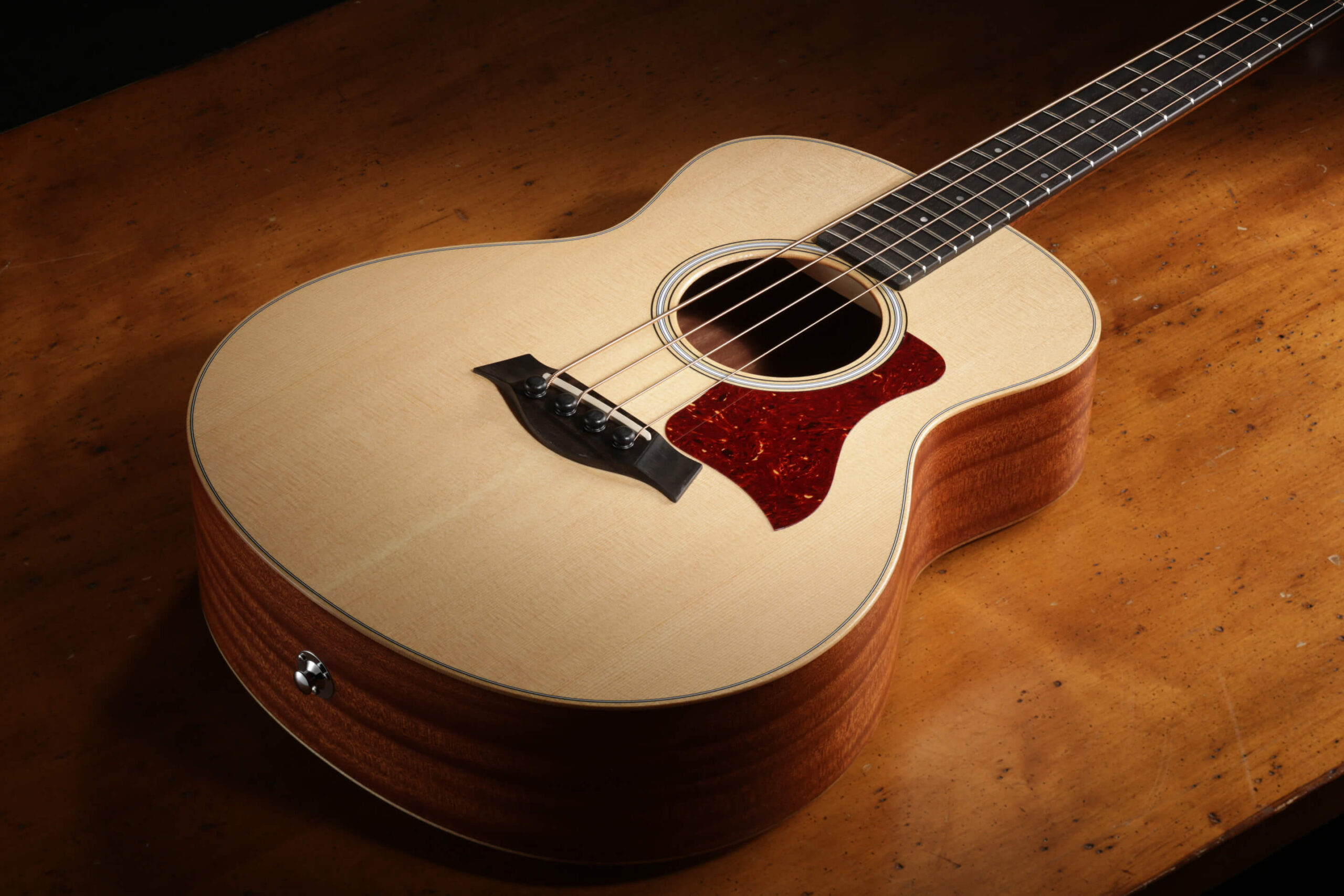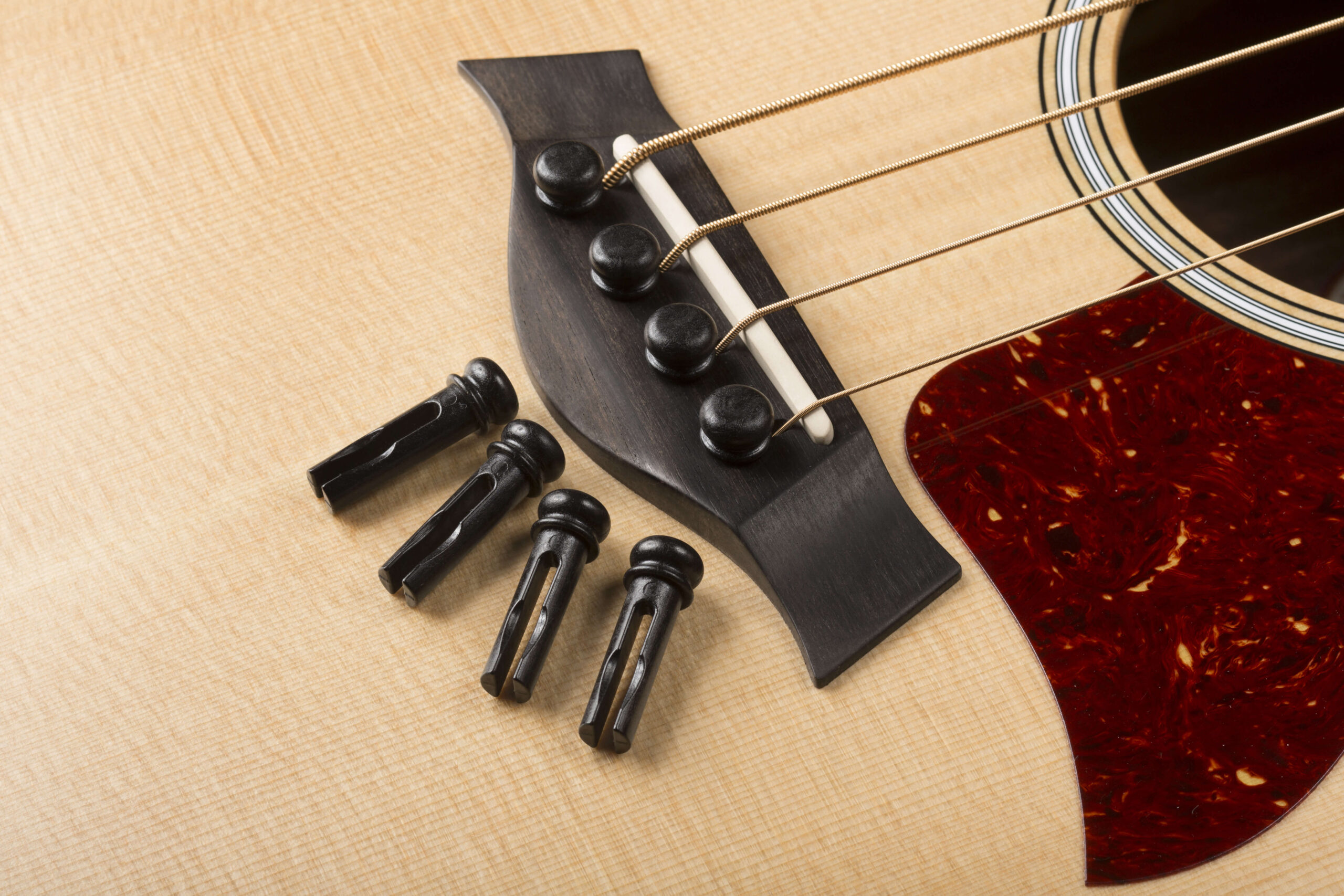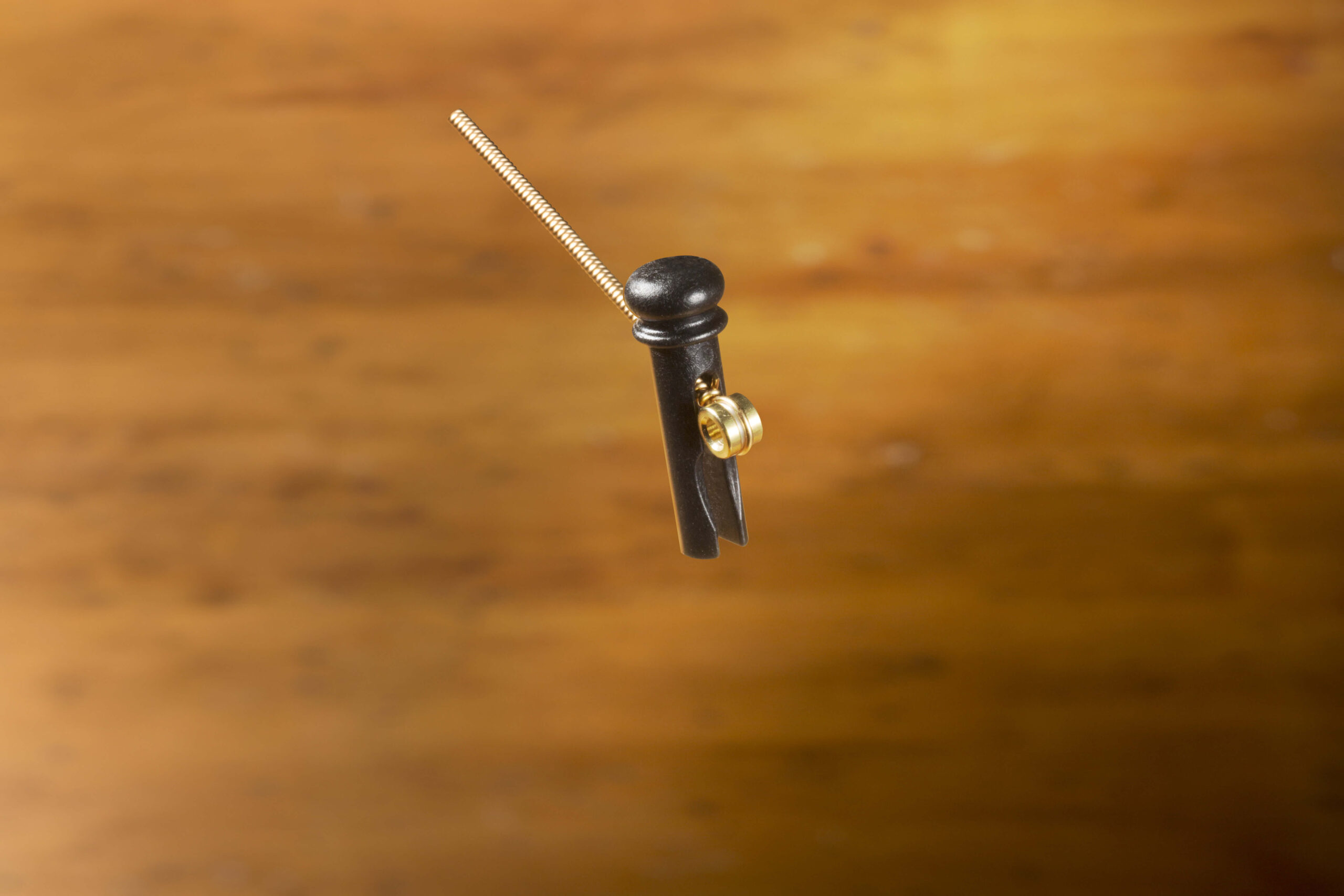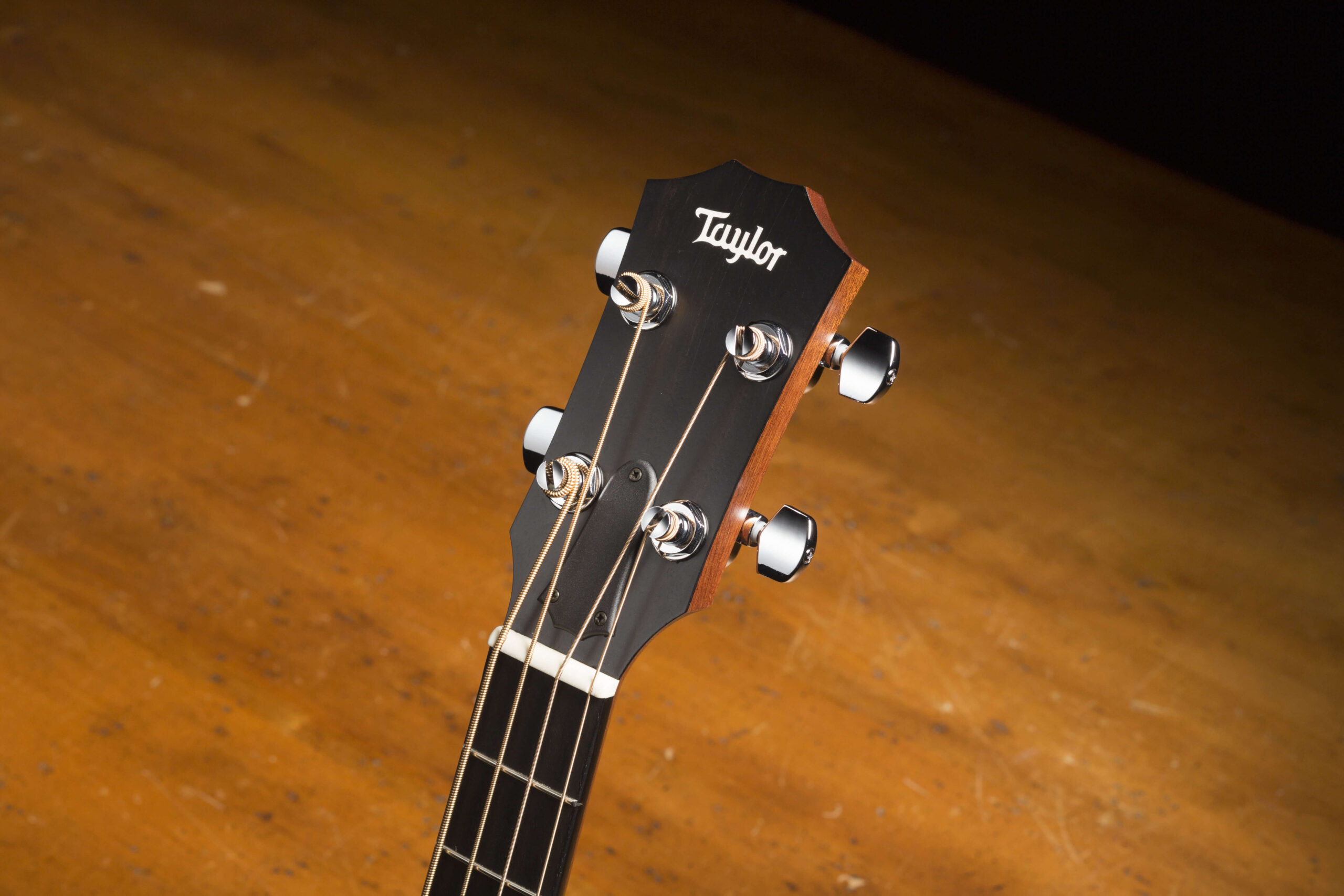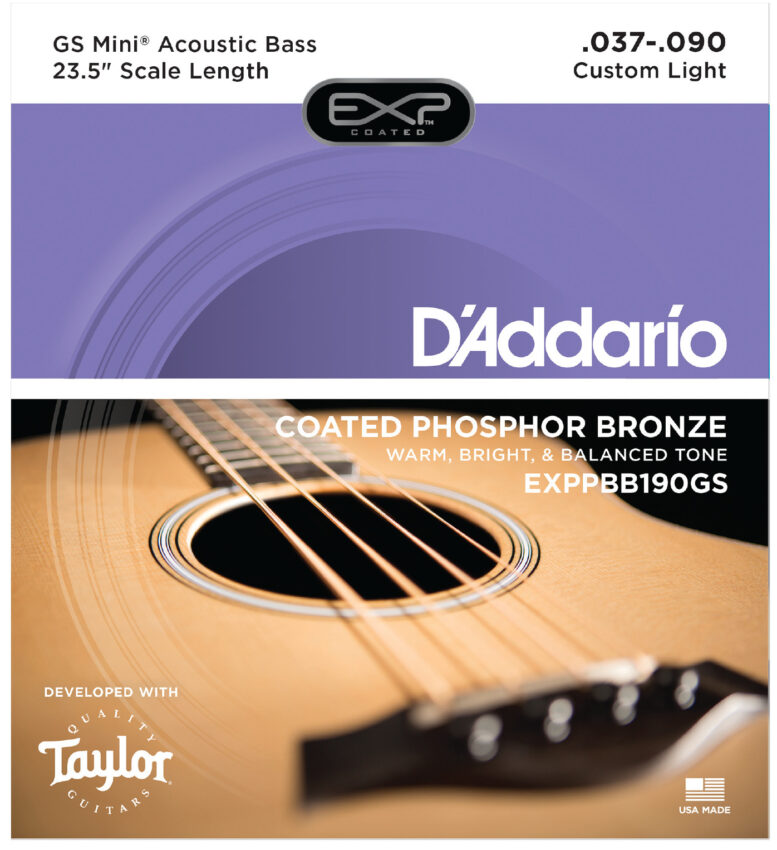Editor’s Note: Elsewhere in this “mini” edition of Wood&Steel, we revisit our 2010 story about the birth of the GS Mini. In keeping with that theme, we thought we’d also bring you the origin story behind its innovative spin-off sibling: the GS Mini Bass, which made its debut in early 2017. By this point, Andy Powers had taken the reins as Bob Taylor’s guitar design successor. The idea of making a musically functional acoustic bass using the Mini’s compact physical proportions (particularly its short string scale length) seemed improbable. But some innovative thinking and a creative collaboration with our friends at D’Addario opened the door to a supremely fun, inspiring and accessible instrument. Read on to learn how they pulled it off.
It started on a lark.
A few years ago, Taylor’s Jesus Jurado, a longtime fabricator on our product development team, was musing with colleague David Judd about the idea of making a bass version of the GS Mini.
“We thought it would be something any guitar player would like to have around the house,” Judd recalls.
One day the two playfully pitched the idea to Andy Powers, egging him on to make one.
“Andy happened to have some ukulele bass strings,” Judd says, “so I modded the poor thing to work as a bass. The strings couldn’t take the extra tension from the longer scale length of the Mini Guitar and broke, so I put on a set of electric bass strings and an ES2 pickup. It didn’t sound great, but it was at least good enough to get Andy’s juices flowing.”
As someone who has played bass in different professional settings over the years, Andy thought the idea of a GS Mini bass was a fun conversation starter, but as a seasoned guitar maker, he was skeptical that it could actually work with such a short scale length.
“I’ve always had a thing for short-scale basses,” he shares. “But often they can’t make accurate bass frequency notes very well due to the quirks of their short string length. They’re fun to play but have some limitations.”
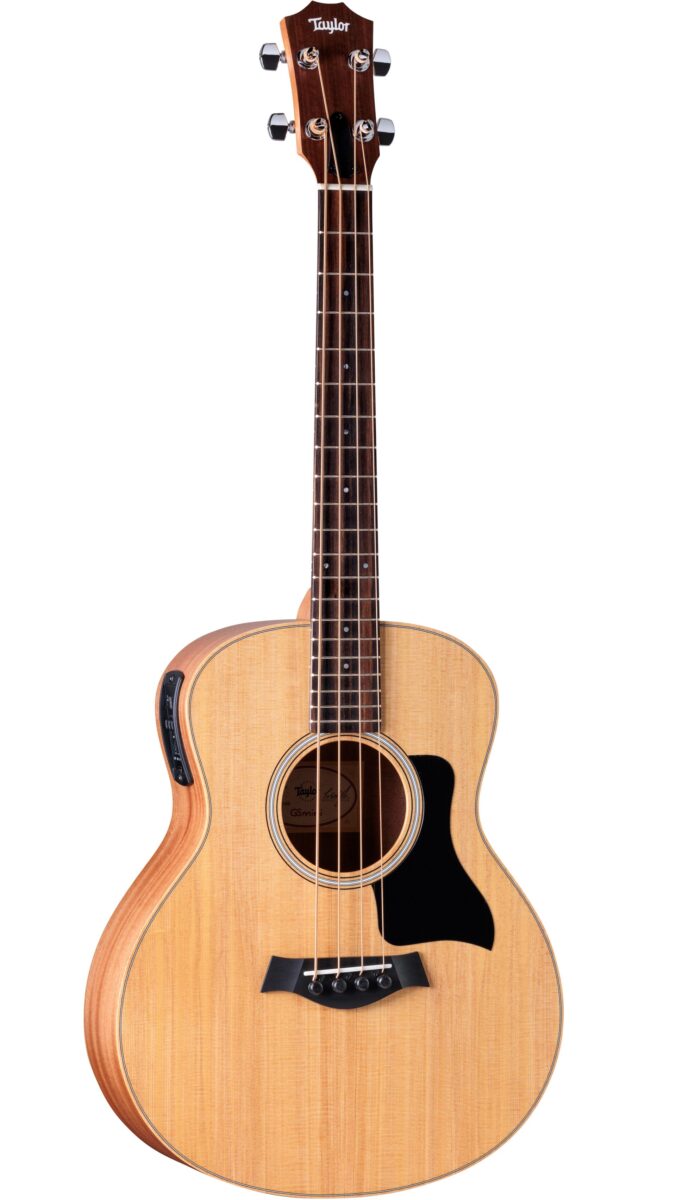
The GS Mini Bass at a Glance
Back/Sides: Layered Sapele
Top: Solid Sitka Spruce
Fretboard/Bridge: Genuine Ebony
Scale Length: 23-1/2 Inches
Nut Width: 1-11/16 Inches
Strings: D’Addario GS Mini Bass Custom Light with EXP Coating
Bridge Pins: Polycarbonate Dual Prong
Finish: Matte
Electronics: ES-B
Case: GS Mini Bass Hard Bag
For reference, the scale length of a standard bass guitar is usually between 32 and 35 inches. The average scale length of a short-scale bass is about 30 inches. The Mini’s string length is 23-1/2 inches.
“Changing a guitar’s scale length a half an inch from 25-1/2 inches to 25 inches is a big deal,” Andy says. “Compared to the standard scale length of a bass guitar, the GS Mini is about 10 inches shorter. It’s almost not the same instrument at that point.”
Putting a regular bass string on the GS Mini and tuning it up, Andy says, would never produce a usable note. An electronic tuner wouldn’t even recognize the resulting vibration as a note. (For a quick primer on string theory and the basic physics of string vibration, see our sidebar on page 14.)
Nonetheless, the idea stuck with Andy (“I really wanted it to exist,” he says), so he began to explore what it would take to make a bass frequency note work with a string length that short. The idea all along, he says, was to work within the basic structural parameters of the existing GS Mini form, for a few reasons.
“I wanted to see if it was possible to build a small, ergonomically friendly bass instrument that lived outside the borders of a typical bass guitar,” he explains. “The hope was to make a bass comfortable and approachable to a guitar player who’s used to a smaller instrument, to a child, or to a seasoned bass player looking for something sized for the couch or tour bus with a different feel and voice. From a manufacturing perspective, there were practical benefits to sharing existing tooling infrastructure with the GS Mini to allow us to make it and have it be affordable.”
Developing New Strings
Off and on for a good year or so Andy experimented with different weights of string, different core sizes, and other variables to determine if he could get a string to make accurate notes with the GS Mini’s scale length, but to no avail. Then he had an epiphany based on some classical guitar prototypes he’d been building.
“I realized I’d been going about it the wrong way,” he says. “It needed to be a nylon string, because the way they are constructed gives them a completely different set of characteristics than steel strings.”
Andy reached out to our development friends at D’Addario, whose strings we use on our nylon-string acoustics, and explained what he was trying to do. Together they walked through all the approaches Andy had already tried.
“They brought in their expertise in making nylon strings for other kinds of instruments,” Andy says. “It’s pretty amazing because they make strings for every kind of string instrument you could name, in just about every kind of material and method. In the end we were able to come up with something that worked really well, which is basically a nylon-core string overwound with a traditional phosphor bronze wrap wire. That combination worked great. Without these strings, I’m not sure this instrument would have been possible.”
The custom string set was developed exclusively for what would become the GS Mini Bass. For more on the strings, see our sidebar.
A New Bridge Pin Design
With the important string issue resolved, Andy turned his attention to another major design challenge: how to properly secure the strings below the bridge and get a good sound.
“With a traditional guitar bridge pin, the string has to come up out of the bridge through a little groove and make an acute bend over the saddle,” he says. “Bass strings are quite large and have a tough time making the bend because the string has such a different stretch factor on the inside of the bend compared to the outside — the strings would deform so much that they would no longer make a correct note. To make the bend more gradual, the bridge would need to be so bulky that it physically wouldn’t sound or work well anymore. Not to mention that it would look ugly and disproportionate on a small instrument.”
After exploring other ideas, Andy devised a new bridge pin design that Taylor has since patented.
“It looks like an old-fashioned clothespin,” he says, holding one up for closer examination to show how the pin splits into two prongs (see photos above).
The dual-prong design accomplishes several things that lead to a better sounding, better-functioning instrument. First, the ball of each string is anchored on the opposite side of the pin (rather than the side closer to the soundhole), which allows the string to pass in between the prongs.
“This extra clearance allows a more gradual bend over the saddle,” Andy says.
Second, a wedging action is created when the string is tuned up that forces the two prongs apart, tightening the pin into its hole.
“The pin essentially becomes self-locking,” Andy explains. “Rather than the typical method of holding your thumb on the bridge pin so it doesn’t go flying out as you tune the string, this new design automatically pulls the pin into the bridge. For restringing, once you loosen the tension on the string, the pin gets looser — it self-releases. As a result, stringing up this guitar will be easier both here in the factory and for the player.”
Together, the gradual bend over the saddle and more secure string anchoring help the instrument sound its best.
Voicing and Other Refinements
With the bridge pin issue resolved, Andy was able to focus on voicing the rest of the instrument, which, by comparison, was relatively easy.
“It’s funny, the two things that held this instrument back for so long were what seem like afterthought details of strings and bridge pins,” he says. “But good instruments need all of the components to be working in a cohesive way.”
Though the internal architecture of the Mini’s body was modified to optimize the voicing of the bass frequencies, Andy says it wasn’t a radical change.
“One of the interesting thoughts that guide an instrument’s design is looking at the body as a mechanical amplifier,” he elaborates. “When it’s a fundamentally good amplifier, it responds remarkably well over a large range of frequencies. As long as the structural considerations don’t change dramatically, you can make something work for a wide range of sounds.”
One of the final design elements to be worked out was the tuners. A couple of the early prototypes featured traditional bass tuning machines, but once it was time for aesthetic refinement, our development team worked closely with one of our tuner suppliers to produce something that was more proportionate for the scale of the GS Mini.
“They have the big post that allows a bass string to work well, but put into a small enough package that you don’t have these giant knobs and extra weight throwing off the visual and physical balance of the bass,” Andy says.
The bass will come equipped with Taylor’s ES-B pickup, which features an onboard preamp with tone and volume controls and a built-in digital chromatic tuner with an LED display for tuning and low battery indication. Andy says the tuner provided one of the measures of success for the design.
“One of the criteria I was using all along was whether or not a tuner could recognize the notes,” he says. “Once we got into the fidelity range where a tuner recognized the pitches, we knew the note had a predictable enough motion to be musical.”
The bass will also come with a customized GS Mini Bass hard bag, which features the bass’s stylized logo treatment on the outside. The hard bag incorporates the same design features as the original GS Mini hard bag, blending protective structure and lightweight portability, with external and internal storage pockets and sewn-in adjustable backpack straps.
The Playing Experience
Considering the massive popularity of the original GS Mini guitar since its release in 2010, the ability to offer players an equally portable and accessible bass sibling — especially given a bass’s typically larger, more prohibitive size — was gratifying for Andy and the design team to bring to production. For starters, it falls in line with Taylor’s heritage of innovation, of pushing instrument design into fresh and inspiring new musical territory. And there’s really no other instrument quite like this on the market. Naturally, with its compact design and slinkier feel, it won’t perform like a conventional bass, nor is it really intended to. It’s made for guitar players like many of us, and like Jesus Jurado and David Judd from our product development team, who thought it would be fun to have an acoustic bass around the house. And that’s what makes it cool — it invites more people to explore the instrument.
“If bass isn’t your primary instrument but you want an acoustic bass on hand for writing, for recording some demos, to have when your friends come over to jam, this is the bass you want,” Andy says. “Anybody can play it. You don’t need calluses on your fingers. It’s physically easier than a guitar. The short string length and the nylon core strings make it so comfortable to play that even a kid or a beginner could walk up to it and not be intimidated. It’s easy enough that my 6-year-old son can press these notes down and play.”
Like its 6-string Mini siblings, the bass is lightweight and portable enough to fit in a plane’s overhead compartment for globe-trekking adventures. And never again will bass players be left empty-handed around a campfire.
As a small-bodied, short-scale instrument, the slinky string response probably won’t be ideally suited for slapping or a heavy attack. But as a bass instrument with a unique feel and good sound, Andy thinks it has a lot to offer.
“It’s no substitute for an upright bass, but there is no other instrument quite like this,” he says. “For a touring bass player doing vocal warm-ups on the band bus, the bassist often has to fake their bass lines on a guitar since not many have an amp to plug their electric bass into. In other scenarios, this instrument does a good job of serving a bassist who simply doesn’t want to haul a big instrument around.”
As Bob Taylor has said, people love the fact that Taylor continues to make products of discovery. When we introduced the Baby Taylor, we didn’t know how many different ways people would end up using it. We’ve seen the same thing happen with the GS Mini. And there’s a good chance it will happen with the bass too, sparking fresh musical ideas as players interact with it.
David Judd, one of the original instigators of the design, is certainly happy with the way the bass turned out.
“It’s a lot of fun to play,” he says. “It’s hard to put it down.”
For Andy, he sees the bass as a kindred spirit of our new Academy Series design philosophy.
“These are all physically and economically approachable instruments that have a lot of musical goodness built in,” he says. “They’re wonderful gateway instruments that encourage people to make playing music part of their lifestyle. With this bass, I would love to see a whole bunch of kids say, ‘I want to be a bass player.’ We need more of you!”
Look for the GS Mini Bass at authorized Taylor dealers starting in February. For complete specs, photos, video content and more, visit taylorguitars.com.
